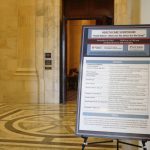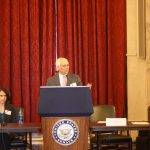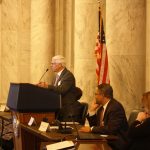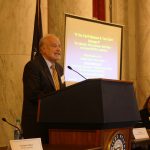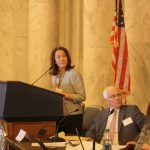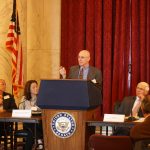On November 18th, Powers Pyles Sutter & Verville and the University of Virginia’s Frank Batten School of Leadership & Public Policy held a healthcare symposium entitled “Health Reform: Where Are We; Where Are We Going?” The symposium took place from 10:00 a.m. to 2:00 p.m. in the Kennedy Caucus Room¹ in the Russell Senate Office Building. The extensive list of speakers included Senate staff; think tank fellows from the RAND Corporation and the Urban Institute; representatives from the Department of Health and Human Services; and UVA professors of health policy, law, economics, and business administration.
Introduction and Objective
Jim Pyles, Principal at Powers and moderator of the event, began by welcoming audience members and briefly reviewing the symposium agenda, objectives and questions to be addressed. His power point slides can be 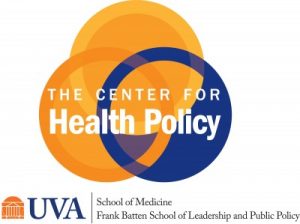 found here. Pyles went on to introduce Dr. Michael D. William, MD, FACS, Director of the Center for Health Policy, the Frank Batten School of Leadership and Public Policy at UVA.
found here. Pyles went on to introduce Dr. Michael D. William, MD, FACS, Director of the Center for Health Policy, the Frank Batten School of Leadership and Public Policy at UVA.
Dr. Michael William also welcomed the guests and discussed his excitement to have UVA involved in the federal healthcare conversation on Capitol Hill. He then explained the meaning behind the three overlapping circles in the UVA Center for Health Policy’s logo. Each of the circles represents a different key healthcare stakeholder: patients, providers, and payers. He noted that the center of the diagram, where all three circles overlap, is where we want to be, but we unfortunately spend far too much time on the outsides of the circles of the diagram.
Congressional Perspective
Three Senate staffers delivered remarks of behalf of their Senators:
- Marvin Figueroa – Office of Senator Mark Warner (D-VA)
- Kristin Malloy – Office of Senator Tim Kaine (D-VA)
- Sarah Schmidt, MPH – Office of Senator Rob Portman (R-OH)
Senator Mark Warner and Senator Tim Kaine additionally wrote letters regarding the current state of healthcare policy and projections for the future.
Marvin Figueroa felt that a tough year lies ahead and much remains uncertain. He believes the Affordable Care Act is not perfect, but that we cannot go back to where we were when women paid higher premiums, insurance could be denied to those with pre-existing conditions, and coverage was sometimes dropped when people got sick. He hopes for bi-partisan breakthrough moving forward.
Sarah Schmidt emphasized that the Republican Party does not wish to simply dismantle the ACA and take away vulnerable people’s healthcare. They, too, want to make great positive improvements to the healthcare system, but their way of going about making such improvements may look different from the ACA. The biggest question in her mind is whether Congress will act in a partisan manner or a bipartisan manner during this process of working towards an outcome with which we can all be comfortable. She emphasized that the ACA itself is a very partisan piece of legislature that got much backing from Democrats and next to none from Republicans. She feels the 2017 budget is the first opportunity right out of the gate for bipartisan partnership, while also noting that Republicans do intend to use reconciliation to repeal the ACA (which would only require 51 votes to pass as opposed to 60). Reconciliation would likely include such moves as pulling back on tax credits and Medicaid expansion, but there would be plans put in place once these things have been peeled back. The goal is sustainable reform and now that we have seen some of the problems of the ACA play out, we know what to fix, she feels.
Kristen Malloy emphasized that Senator Kaine’s main objective is to protect gains made under the ACA, but continue working towards positive change in healthcare. She felt there was no question more must be done to lower healthcare costs while also raising quality.
Peter Thomas, Principal at Powers asked the three Senate staffers to comment on what a daunting task it would be to extract a six year program from an already somewhat fragmented healthcare market. Where does one start, he questioned.
Figueroa responded that we all want positive change, but we must be careful. One party says to start all over, while the other feels we are too far in. Knowing how hard it was to create the ACA in the first place, it makes little sense to scrap it entirely and start over.
Schmidt noted that if we are talking about insurance reform, we need to have the buy in of the insurance companies. We all need to be working with each other and consulting one another, both in the government and also in the industry.
Think Tank Presentations
Christine Eibner, Senior Economist at the RAND Corporation and author of “The Affordable Care Act in Depth,” gave a presentation entitled “Health Reform 2.0: Options for Modifying or Replacing the Affordable Care Act”4. Christine Eibner RAND Presentation (D0696237) The report covered a wide range of policy topics and misconceptions in healthcare policy, including estimations from the CBO that repealing the ACA would increase the federal deficit by roughly $145 billion and favorability ratings of different ACA provisions (some of which enjoy widespread, bipartisan support). She also emphasized RAND as a resource for Congress.
Bob Berenson, Fellow at the Urban Institute, gave a presentation entitled “If You Can’t Measure It, You Can’t Manage It” The Misquote That Launched 1000 Ships – or at Least MACRA Legislation.” He feels we have gone overboard with quality measurements and the consequence is that we are not identifying the hugely important healthcare issues that cannot be quantified. Thus, work regarding measurement needs to be refocused and made more efficient. Furthermore, he noted that exchanges and coverage/Medicaid extension are the two big issues that people think about when they think about the ACA and that it is important to emphasize that the ACA is so much more than just those two pieces.
CMS Presentation
Kevin Counihan, Director of the Center for Consumer Information and Insurance Oversight, Department of Health and Human Services, reported on the ACA in terms of the numbers, marketplace stability, innovation, upcoming Open Enrollment, and thoughts on the future of the program. His presentation was entitled “The Health Insurance Marketplace: Expanded Access, Smarter Spending, Better Care and Healthier People.”
Moderator Jim Pyles briefly expanded upon some of Counihan’s comments in regards to how so much of the healthcare system depends on the relationship of trust between the physician and patient and that we must work hard to preserve that relationship. As an example of successful, bipartisan health reform, he mentioned the Independence at Home program as one of the most successful programs the CMS has ever tested and the top recommendation of the Bipartisan Chronic Care Working Group.
Dr. William of UVA commented that there is great cognitive dissonance around our healthcare systems. He emphasized the “s” in systems, clarifying that we have multiple systems with local problems and local solutions, not just one big overall system. He felt we have a fundamentally flawed idea in this country that businesses must pay for healthcare insurance. He asked the audience to “name one other thing we pay for that we do not know the price of, other that healthcare.” He feels that we have a responsibility to innovate, to ask ourselves what we are personally willing to “pony up” for our own healthcare, and to take responsibility for the fact that if we choose to go with the Rolls Royce version of healthcare then other areas of government spending will have to be cut.
An audience member posed the question “What about the people who cannot take full responsibility for their healthcare? How do we integrate them into the system? And what is the role of healthcare for those who fall through the safety net?”
Dr. William responded that if we look at the European countries, we will notice that they spend more on social welfare, which in many ways means they work to provide sources of preventative care. This is something for us to consider. He also mentioned that as we advance in healthcare, innovation will get more expensive. There is much talk about “bending the cost curve” of healthcare, but he urges that we should never try to completely eliminate that curve because that means we have stopped advancing.
Panel #1
Dr. Michael William presented a datagraphic that outlined improved outcomes of population health initiatives. He explained that if your city does not have clean drinking water, walking spaces, and so on, no amount of medical expenditure is going to be able to fix the subsequent negative health outcomes. He noted that, as a surgeon, he knows the ideal situation is if people remain healthy enough that they never need surgery. He gave an example of an effective community healthcare model where a food bank shared a wall with a primary care physician and nutritionalist, all working in tandem. He also emphasized the need to use resources wisely, with HIPAA as his example of an initiative that uses far too many resources for far too little returns.
Margaret (Mimi) F. Riley, JD; Professor of Law, General Faculty; Professor of Public Health Sciences, School of Medicine; Professor of Public Policy, Batten School of Leadership and Public Policy at UVA; gave a presentation entitled “Health Care Symposium: ‘Health Reform: Where are We; Where are We Going?’” Riley said she feels HIPAA is a major obstacle to healthcare research. She went on to note, “If you want to know about healthcare in America, spend some time in waiting rooms.” Her presentation boiled down to her belief that the entire United States healthcare system come could be explained using the following five bullet points:
- Access
- Quality
- Affordability/Cost
- Choice
- Justice
Riley also stressed that lawmakers need to get outside Washington to have honest conversations about healthcare as opposed to speaking in sound bites, and that Charlottesville is a great resource close by.
Moderator Pyles noted that, indeed, the best way to go about health reform is bottom-up rather than the top down.
Panel #2
Margaret C. Tracci, MD, JD, Co-director of UVA School of Medicine Health Policy Working Group, gave a presentation entitled “The Move to Value: Provider and Patient Perspective on Opportunities and Pitfalls.” She argued that we must not regress to only using big data for policy, as full outcomes cannot be summed up in a VALUE= OUTCOME/COST chart. Many times the overall findings with this data have very little meaning to providers, let alone patients. She lamented that every minute a care provider spends on billing, the electronic record, and such is a moment away from meaningful interaction with the patient. Her overall conclusion was that we need to be balancing big data on costs and savings with small data on patient impact, while being especially attentive to the small data.
Brooke Lehmann, Batten School of Leadership and Public Policy, UVA; Partner, Capital Works, LLC; was to deliver a presentation on “Child and Adolescent Health Care: Thoughts on Where We Are and Opportunities for Moving Forward.” She was unable to attend last minute, so G. Paul Matherne, M.D. spoke on her behalf. Some of his main points included the increase in numbers of patients moving through the system due to the increase in what healthcare can do for patients, as well as the existence of many different buckets of patients with many different types of needs. He stressed the need for preventative health, noting “costs today are savings tomorrow.” He also stressed accessibility as an issue, particularly rural America’s access to chronic and high tech care. Lastly, he noted that “children are not just little adults,” they have unique needs and what we invest in now will pay off later.
Christopher J. Ruhm, PhD, Professor of Public Policy and Economics, Frank Batten School of Leadership and Public Policy at UVA, spoke about the future of the ACA and how most system changes tend to have conflicting trade-offs. He spoke about the “three and a half” option for the ACA: repeal and replace, repeal and delay, do nothing (unlikely), and modify and relabel. He emphasized that it is important to remember that healthcare was a mess before the ACA came into play, so not to act as though all issues in the system extend solely from implementation of the ACA. He noted that President-elect Trump’s proposals have become relatively modest at this point, and also that federal standards in terms of healthcare are important because states have less analytical ability to think through all possible options. He predicts a rebranding of Medicaid expansion, an increase in flexibility on the state level, and much discussion surrounding why the price of healthcare is so high in the United States.
Mary Margaret Frank, BS, MAcc, PhD, Associate Professor of Business Administration, Academic Director for Institute for Business in Society, The Darden School of Business at UVA, spoke about the business side of the healthcare system. She emphasized the importance of understanding the motivation and incentives for doctors — many say the patient is the most important, but she would argue the physician is equally important. She feels we have changed healthcare from profession to a vocation because so much of it is electronically “checking boxes” now. She urges us to consider the difference between leadership and compliance, also noted the statistics showing that the number of healthcare professionals looking to for a second job or switch out of the field are alarming and disappointing (30-40%).
Moderator Pyles concluded the symposium with the statement that the biggest opportunity of many of our careers in healthcare is ahead of us, as all the chips are in the air.
- Powers Pyles Sutter & Verville, in conjunction with the the University of Virginia’s Frank Batten School of Leadership & Public Policy held a healthcare symposium entitled “Health Reform: Where Are We; Where Are We Going?”
- Powers Pyles Sutter & Verville Principal and Co-Founder Jim Pyles speaks, with Dr. Michael Williams of the UVA Batten School of Leadership and Public Policy and Christine Eiber of the RAND Corp. to his sides.
- Dr. Michael Williams of the UVA Batten School of Leadership and Public Policy speaks at the health reform event.
- Sarah Schmidt, MPH, Office of Senator Rob Portman (R-OH) and Marvin Figueroa, Office of Senator Mark Warner (D-VA) look on as Kristin Malloy, Office of Senator Tim Kaine (D-VA) speaks.
- Crowd at the health reform symposium.
- Jim Pyles of Powers Pyles Sutter & Verville answers questions, with Dr. Michael Williams of the UVA Batten School of Leadership and Public Policy and Powers Principal Peggy Tighe nearby.
- Christine Eiber of the RAND Corp. speaks to a crowded room at the health reform symposium.
- Bob Berenson of the Urban Institute speaks at the health reform symposium on Capitol Hill.
- Kevin Counihan of CMS speaks at the health reform symposium on Capitol Hill.
- Margaret Tracci, Co-director of University of Virginia School of Medicine Health Policy Working Group looking to her presentation during her speech at the health reform symposium on Capitol Hill.
- Christopher Ruhm, Professor of Public Policy and Economics, UVA Frank Batten School of Leadership and Public Policy speaking at the health reform event.
¹Fun fact: Other events to have taken place in this historic room including the following well-known Senate investigative hearings the: Sinking of the Titanic (1912), “Teapot Dome” Oil Reserves (1923-1924), Wall Street Banking Practices (1932-1934), World War II National defense Program (1941-1947), Army-McCarthy Dispute (1954), Labor Union Racketeering (1957-1958), Vietnam War (1966), Watergate Break-In (1973), Vice Presidential Nomination of Nelson A. Rockefeller (1974), Iran-Contra Affair (1987), and Supreme Court Nomination of Clarence Thomas (1991).
For more information regarding the Health Reform Symposium on Capitol Hill, please contact Powers Principal and co-founder Jim Pyles at Jim.Pyles@PowersLaw.com or (202) 872-6731 or Powers Principal Peggy Tighe at Peggy.Tighe@PowersLaw.com or (202) 872-6752. For more photos from the event, please visit our Facebook page.


